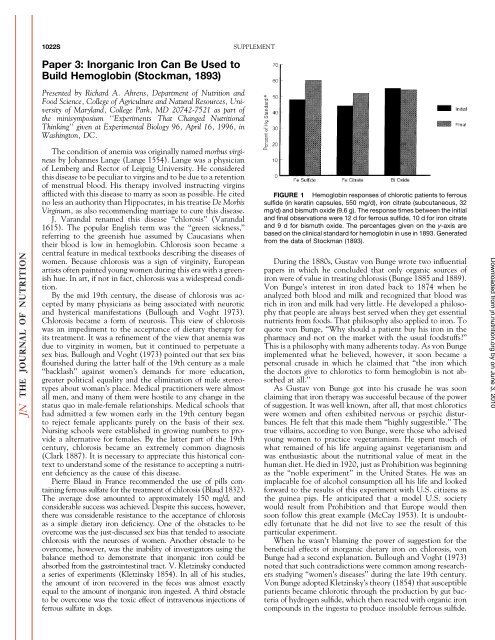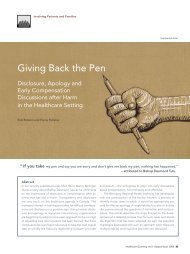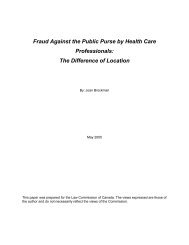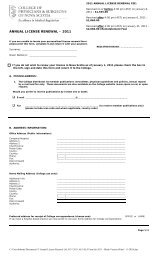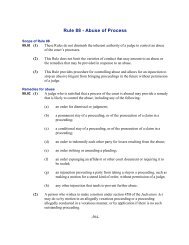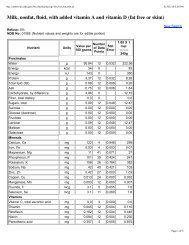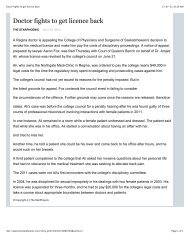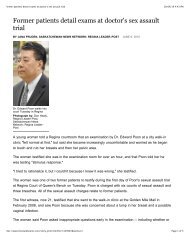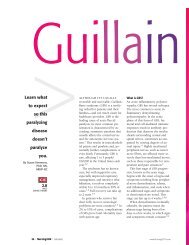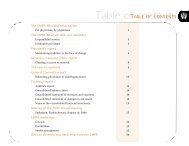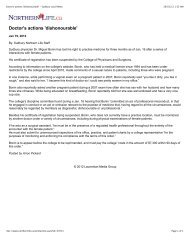Experiments That Changed Nutritional Thinking - TUUM EST
Experiments That Changed Nutritional Thinking - TUUM EST
Experiments That Changed Nutritional Thinking - TUUM EST
You also want an ePaper? Increase the reach of your titles
YUMPU automatically turns print PDFs into web optimized ePapers that Google loves.
1022S<br />
SUPPLEMENT<br />
Paper 3: Inorganic Iron Can Be Used to<br />
Build Hemoglobin (Stockman, 1893)<br />
Presented by Richard A. Ahrens, Department of Nutrition and<br />
Food Science, College of Agriculture and Natural Resources, University<br />
of Maryland, College Park, MD 20742-7521 as part of<br />
the minisymposium ‘‘<strong>Experiments</strong> <strong>That</strong> <strong>Changed</strong> <strong>Nutritional</strong><br />
<strong>Thinking</strong>’’ given at Experimental Biology 96, April 16, 1996, in<br />
Washington, DC.<br />
The condition of anemia was originally named morbus virgineus<br />
by Johannes Lange (Lange 1554). Lange was a physician<br />
of Lemberg and Rector of Leipzig University. He considered<br />
this disease to be peculiar to virgins and to be due to a retention<br />
of menstrual blood. His therapy involved instructing virgins<br />
afflicted with this disease to marry as soon as possible. He cited FIGURE 1 Hemoglobin responses of chlorotic patients to ferrous<br />
no less an authority than Hippocrates, in his treatise De Morbis sulfide (in keratin capsules, 550 mg/d), iron citrate (subcutaneous, 32<br />
Virginum, as also recommending marriage to cure this disease. mg/d) and bismuth oxide (9.6 g). The response times between the initial<br />
J. Varandal renamed this disease ‘‘chlorosis’’ (Varandal and final observations were 12 d for ferrous sulfide, 10 d for iron citrate<br />
1615). The popular English term was the ‘‘green sickness,’’ and 9 d for bismuth oxide. The percentages given on the y-axis are<br />
referring to the greenish hue assumed by Caucasians when based on the clinical standard for hemoglobin in use in 1893. Generated<br />
from the data of Stockman (1893).<br />
their blood is low in hemoglobin. Chlorosis soon became a<br />
central feature in medical textbooks describing the diseases of<br />
women. Because chlorosis was a sign of virginity, European During the 1880s, Gustav von Bunge wrote two influential<br />
artists often painted young women during this era with a greenish<br />
papers in which he concluded that only organic sources of<br />
hue. In art, if not in fact, chlorosis was a widespread condi- iron were of value in treating chlorosis (Bunge 1885 and 1889).<br />
tion.<br />
Von Bunge’s interest in iron dated back to 1874 when he<br />
By the mid 19th century, the disease of chlorosis was ac- analyzed both blood and milk and recognized that blood was<br />
cepted by many physicians as being associated with neurotic rich in iron and milk had very little. He developed a philoso-<br />
and hysterical manifestations (Bullough and Voght 1973). phy that people are always best served when they get essential<br />
Chlorosis became a form of neurosis. This view of chlorosis nutrients from foods. <strong>That</strong> philosophy also applied to iron. To<br />
was an impediment to the acceptance of dietary therapy for quote von Bunge, ‘‘Why should a patient buy his iron in the<br />
its treatment. It was a refinement of the view that anemia was pharmacy and not on the market with the usual foodstuffs?’’<br />
due to virginity in women, but it continued to perpetuate a This is a philosophy with many adherents today. As von Bunge<br />
sex bias. Bullough and Voght (1973) pointed out that sex bias implemented what he believed, however, it soon became a<br />
flourished during the latter half of the 19th century as a male personal crusade in which he claimed that ‘‘the iron which<br />
‘‘backlash’’ against women’s demands for more education, the doctors give to chlorotics to form hemoglobin is not abgreater<br />
political equality and the elimination of male stereo- sorbed at all.’’<br />
types about woman’s place. Medical practitioners were almost As Gustav von Bunge got into his crusade he was soon<br />
all men, and many of them were hostile to any change in the claiming that iron therapy was successful because of the power<br />
status quo in male-female relationships. Medical schools that of suggestion. It was well known, after all, that most chlorotics<br />
had admitted a few women early in the 19th century began were women and often exhibited nervous or psychic disturbances.<br />
to reject female applicants purely on the basis of their sex.<br />
He felt that this made them ‘‘highly suggestible.’’ The<br />
Nursing schools were established in growing numbers to pro- true villains, according to von Bunge, were those who advised<br />
vide a alternative for females. By the latter part of the 19th young women to practice vegetarianism. He spent much of<br />
century, chlorosis became an extremely common diagnosis what remained of his life arguing against vegetarianism and<br />
(Clark 1887). It is necessary to appreciate this historical context<br />
was enthusiastic about the nutritional value of meat in the<br />
to understand some of the resistance to accepting a nutri- human diet. He died in 1920, just as Prohibition was beginning<br />
ent deficiency as the cause of this disease.<br />
as the ‘‘noble experiment’’ in the United States. He was an<br />
Pierre Blaud in France recommended the use of pills con- implacable foe of alcohol consumption all his life and looked<br />
taining ferrous sulfate for the treatment of chlorosis (Blaud 1832). forward to the results of this experiment with U.S. citizens as<br />
The average dose amounted to approximately 150 mg/d, and the guinea pigs. He anticipated that a model U.S. society<br />
considerable success was achieved. Despite this success, however, would result from Prohibition and that Europe would then<br />
there was considerable resistance to the acceptance of chlorosis soon follow this great example (McCay 1953). It is undoubtedly<br />
as a simple dietary iron deficiency. One of the obstacles to be<br />
fortunate that he did not live to see the result of this<br />
overcome was the just-discussed sex bias that tended to associate particular experiment.<br />
chlorosis with the neuroses of women. Another obstacle to be When he wasn’t blaming the power of suggestion for the<br />
overcome, however, was the inability of investigators using the beneficial effects of inorganic dietary iron on chlorosis, von<br />
balance method to demonstrate that inorganic iron could be Bunge had a second explanation. Bullough and Voght (1973)<br />
absorbed from the gastrointestinal tract. V. Kletzinsky conducted noted that such contradictions were common among researchers<br />
a series of experiments (Kletzinsky 1854). In all of his studies,<br />
studying ‘‘women’s diseases’’ during the late 19th century.<br />
the amount of iron recovered in the feces was almost exactly Von Bunge adopted Kletzinsky’s theory (1854) that susceptible<br />
patients became chlorotic through the production by gut bac-<br />
teria of hydrogen sulfide, which then reacted with organic iron<br />
compounds in the ingesta to produce insoluble ferrous sulfide.<br />
equal to the amount of inorganic iron ingested. A third obstacle<br />
to be overcome was the toxic effect of intravenous injections of<br />
ferrous sulfate in dogs.<br />
/ 4p09$$0062 04-07-97 14:02:12 nutras LP: J Nut May Suppl<br />
Downloaded from jn.nutrition.org by on June 3, 2010


